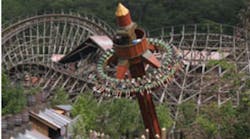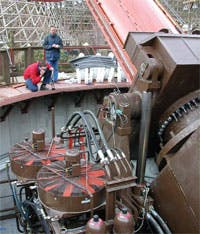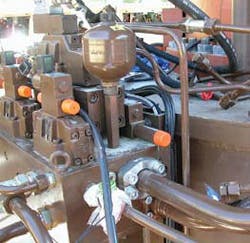Ride simulators are great for providing a virtual adventure that stimulates the senses. Participants see, hear, and sometimes smell a virtual environment enhanced by carefully orchestrated motion that is precisely choreographed with the visual program.
As closed-loop motion control has evolved, ever more sophisticated simulators have been introduced to feed the public’s continuing hunger for the latest and greatest attraction. Plus, because they are often less expensive to operate than traditional rides, take up less real estate, and often pose less risk of liability than traditional rides, ride simulators have been popular with theme park owners as well.
However, successful theme parks must contain a variety of new attractions to keep customers coming back year after year. Roller coasters and simulators may be considered headline attractions, but the dozens of other traditional rides at amusement parks accommodate thousands of visitors every day. Many are seeking an alternative to waiting an hour in line for a two-minute roller coaster ride, while others prefer traditional fixed rides over the virtual experience of a simulator.
Thrills from multi-axis motion
Among the newest major attractions at Dollywood, Pigeon Forge, Tenn., is Timber Tower, a fixed ride that opened in 2006. Designed and built by Huss Maschinenfabrik GmbH & Co. KG, Bremen, Germany, Timber Tower is the first of its kind in North America. A 27-ft diameter passenger gondola carrying as many as 40 people rises 65 ft skyward before it plummets downward. The tower pivots to 30° from horizontal and features dual rotation — the gondola rotates at up to 11 rpm around the tower itself, and the ride base also rotates.
Timber Tower plunges passengers almost within reach of a sawmill blade, a bear cave, a water geyser, a beaver dam, and a treacherous log jam. Of course, all of these sights fit in perfectly with the backwoods theme of Dollywood.
Although Timber Tower is the first ride of its kind in North America, it’s not the first in the world. Huss previously designed and built El Volador for Bellewaerde theme park in Belgium. Apart from visual adornments, El Volador and Timber Tower are identical. They share the same hydraulic, electrical, mechanical, and structural design. El Volador is styled after a legendary bird, whereas Timber Tower conforms to Dollywood’s setting in the Great Smoky Mountains.
All the right moves
In both cases, riders experience multiple axes of motion. One moves the gondola up and down the axis of the tower, a second spins the gondola around the center axis of the tower, a third tilts the tower more than 60° from vertical, and a fourth rotates the base so the tower can pivot in different directions.
As with all amusement park attractions, safety is the tip priority. But a main challenge for this attraction is coordinating all the motion of the multiple axes, not the least of which is pivot control of the tower. Tower pivoting is controlled by a pair of opposed hydraulic cylinders. Each cylinder is positioned on opposite sides of a pivot point near ground level, so as one cylinder is extending, the other is retracting. This presents the formidable task of positioning a cantilevered beam with a heavy load at the beam’s free end.
A fully loaded gondola weighs thousands of pounds, so a 93-ton counterweight aids control and reduces the amount of energy. Not surprisingly, then, energy conservation becomes an issue. The attraction’s drive requires 120 kW, which does not include power for lights, so designers at Huss kept an eye toward energy-conserving techniques.
One of these technique reduces the amount of high-pressure fluid needed by the cylinder drive. Maximum cylinder force is needed only when the tower is near the end of its arc — when maximum acceleration and deceleration occurs. When the tower is near the midpoint, momentum is high enough that it does not need full hydraulic force from the cylinders to maintain motion. When maximum cylinder force is needed, pressurized fluid is routed to the cap end of a cylinder. But when lower force is needed, pressurized fluid is routed instead to the rod end of the opposing cylinder. This reduces the volume of high-pressure fluid required, which saves energy.
Huss engineers commissioned a Bosch Rexroth Dutch subsidiary in Boxtel, Netherlands for the delivery of the entire hydraulic and electric drive and control technology for Timber Tower, El Volador, and four other incarnations of the attraction.
Marc Mulders, project manager at Bosch Rexroth in Boxtel, explained that the ongoing project design and construction combined the expertise of multiple business units. “In addition to components, we also offer complete one-stop solutions. Thus, we were able to gear the entire drive and control system to stringent TV safety requirements and construct and install it accordingly,” said Mulders.
Even though this equipment is not subjected to the heavy shock, vibration, and other challenges of many industrial applications, it is not without its challenges. For example, amusement park attractions typically must operate continuously for 12- to 14-hr days, seven days a week for months on end. The equipment must also operate within a wide range of temperatures and weather conditions.
Engineers knew they needed more than a chrome plating typically used on piston rods. Consequently, they decided to use cylinders with Ceramax coated piston rods manufactured at Bosch Rexroth B.V. in Boxtel. The Ceramax application process allows for fine-tuning of layers to specific application demands. Each layer is applied with advanced processes like plasma spraying and high-velocity oxy-fuel spraying, which produces clean, hard, and dense coatings with a fine, homogeneous structure.
Several different mixes of ceramic or metal matrix materials can be applied, depending on requirements for wear, corrosion resistance, and service life. Introduced in 1989, Ceramax rod coatings have been applied to more than 14,000 hydraulic cylinders in operation in a wide range of demanding applications.
See it in action
Ride manufacturer Huss Maschinenfabrik Gmbh coined the term Topple Tower to describe the various versions of the ride described here as Timber Tower and El Volador. Huss has built six of these rides, which are all essentially the same ride, with different visual adornments to adhere to a theme. For example, the top of the tower may have the head of an eagle, dodo, or other bird, a dragon, or giraffe, or simply take on the theme of a falling timber.
Click here to view a video of the Topple Tower in action.




